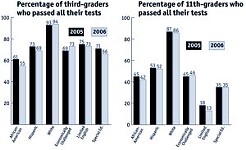Study: Parking Lots Pollute
Common pavement sealant could be damaging waterways
By Rachel Proctor May, Fri., July 1, 2005

A new study by the city of Austin and the U.S. Geological Survey suggests that coal-tar sealant, the shiny black stuff that goes on parking lots to protect asphalt from the elements, may be a major source of water pollution in Austin.
Coal-tar sealant is composed largely of polycyclic aromatic hydrocarbons, or PAHs, a family of chemicals that have been increasing nationwide in urban waterways over about the last 30 years. No one knows why. One thing that is known, however, is that PAH "hot spots," or areas of intense contamination, are frequently located near parking lots. According to Peter Van Metre of the USGS, previous scientific literature included examination of tailpipe emissions, used motor oil, worn-off bits of tires, and several other sources, but did not include examination of coal-tar sealants.
Scientists from the city's Watershed Protection and Development Review Department had been studying PAH hot spots since the late 1990s, but it wasn't until 2001 that they started collaborating with the USGS. The partnership began, Van Metre recalled, when city scientists approached the USGS with sediment from local waterways showing levels of PAH contamination that Van Metre found literally unbelievable.
"Our first reaction was we thought their data were wrong," he said. "We thought there must be a lab problem, the numbers were so high."
It wasn't a lab problem. In 2003, spurred by a public controversy over PAH contamination in Barton Springs, the City Council ordered the WPDRD to study the environmental impacts of coal-tar sealant on area waterways. Even though sealant by definition is supposed to stay stuck to the pavement, the fact that parking lots must be resealed from time to time suggests that sealants do, in fact, break down. The team's preliminary results, released last summer, supported that argument – they found that PAH contamination in runoff from sealed parking lots was 65 times higher than in runoff from unsealed parking lots. Wednesday's report, which will be published in the journal Environmental Science & Technology in August, charges that the sealant may be responsible for some 90% of the PAH contamination in parking lot runoff. Previous studies had pointed to parking lots as one of the largest sources of PAH contamination in urban waterways, so the study could be a significant breakthrough in efforts to protect lakes and streams in Austin, and elsewhere. "If you can reduce a major source of contamination by 90 percent, you've had a big impact," Van Metre said.
The city's legal department is looking into possibilities for a ban on the coal-tar sealants, one of two major kinds sold in Austin (the other is asphalt-based). WPDRD estimates that some 600,000 gallons of the former are applied annually throughout the Austin area.
Pavement Coatings Technology Center representative Kevin Hardin argued that because PAHs come from many sources, a ban on one source could not solve the problem of PAH contamination. Bruce Lowry, of local company Wheeler Coatings Asphalt Inc., confirmed that his company and other industry representatives have long been in communication with the WPDRD and are aware of the study, although he declined to comment on its findings beyond saying he looked forward to a scheduled meeting with city reps in July to "learn more." Lowry said in an e-mail that if the city does ban coal-tar sealant, "There may be little impact, as many seal coating manufacturers are making asphalt emulsions. The City is and has been evaluating these sealants." (Wheeler Coatings, he pointed out, already uses asphalt emulsions.)
The city's efforts to understand PAHs won't end with the publication of the study. The WPDRD has undertaken a second set of studies, now in the peer review phase, to assess the impact high levels of PAH contamination have on aquatic life. Using three different methodologies, the scientists found that not only are PAHs toxic to aquatic creatures, they're toxic at levels that already exist in Austin waterways – and the problem is clearly getting worse.
"The concentrations in Town Lake are increasing pretty dramatically," said city biologist Mateo Scoggins, who added that if the trend continues unabated, at some point the lake would be akin to "a Superfund site."
Many Austinites may find that rather creepy, considering the fact that Town Lake is where most residents get their drinking water. In their memo to council explaining the study, however, the researchers stressed that no evidence exists suggesting PAH contamination in water is a threat to human health. (The reason is that PAH molecules bind to sediment – you're in good shape unless you're literally drinking mud.) It also points out that no information is available regarding whether other pathways of exposure, such as breathing fumes or walking over coal-tar sealed pavement, poses a health risk. Still, Van Metre pointed out that if PAHs can get themselves unstuck enough from the pavement to flow into the water, then it's certainly worth looking into whether they get unstuck in other places, such as playgrounds, and cause health problems.
Whatever the local impacts, the study is likely to kick off further research nationwide. Don Sparling, a wildlife toxicologist at Southern Illinois University who studies amphibians and who has written a proposal to the Austin Community Foundation to work with WPDRD to study the impact of the sealant on the Barton Springs salamanders, said that better understanding of the sealant connection could help advance explorations of why so many amphibian species are in decline worldwide.
"The use of sealants, either asphalt or coal-tar, is very widespread and it's an issue that really hasn't been explored before," Sparling said. "This could have a potentially broader impact than just [salamanders]."
Got something to say on the subject? Send a letter to the editor.










